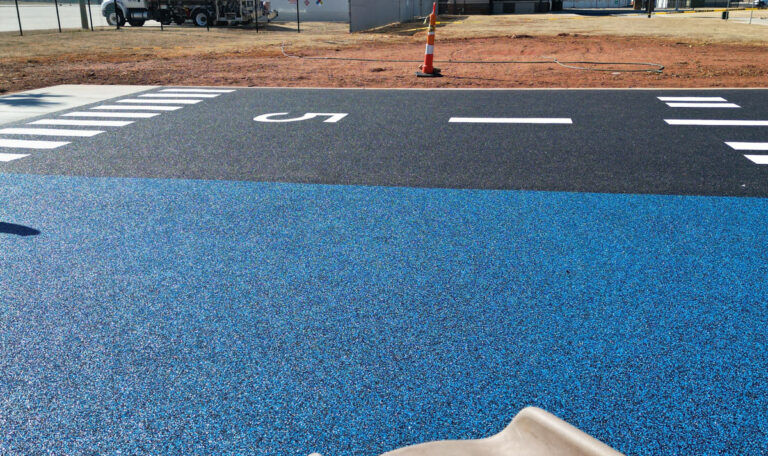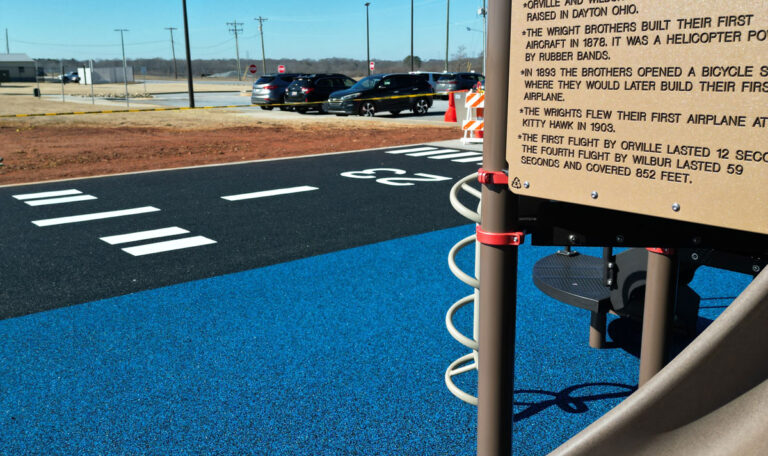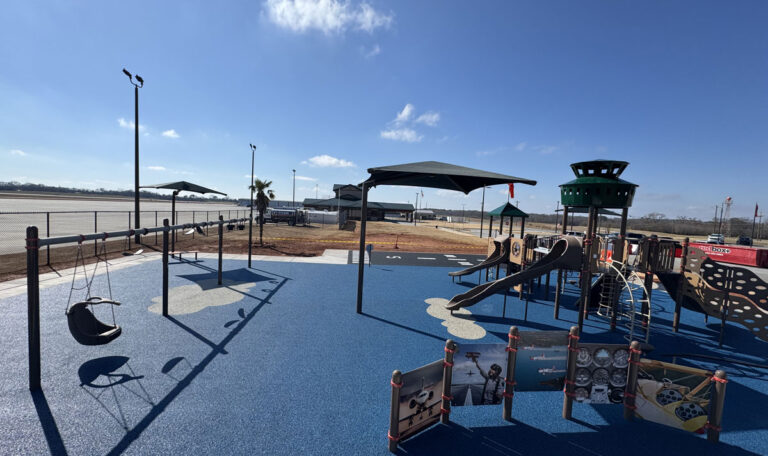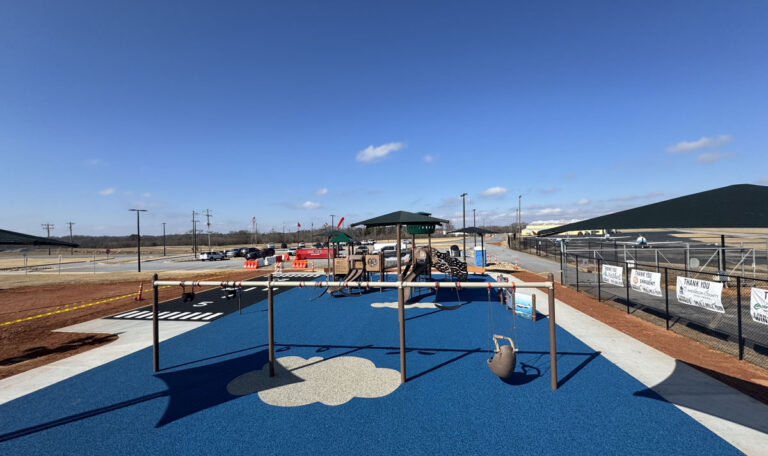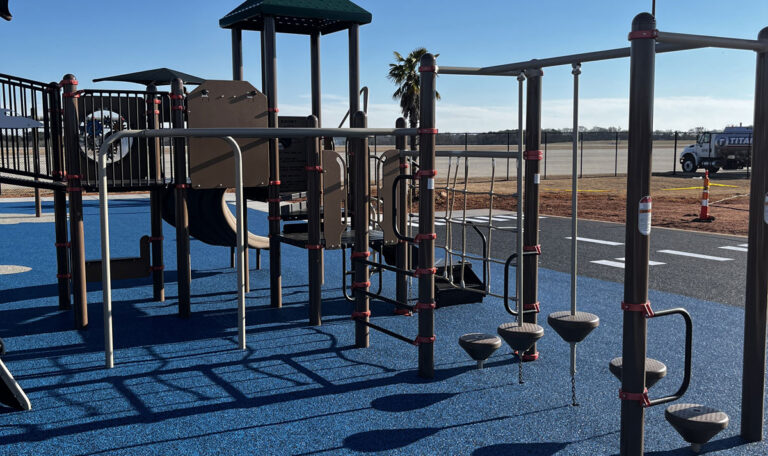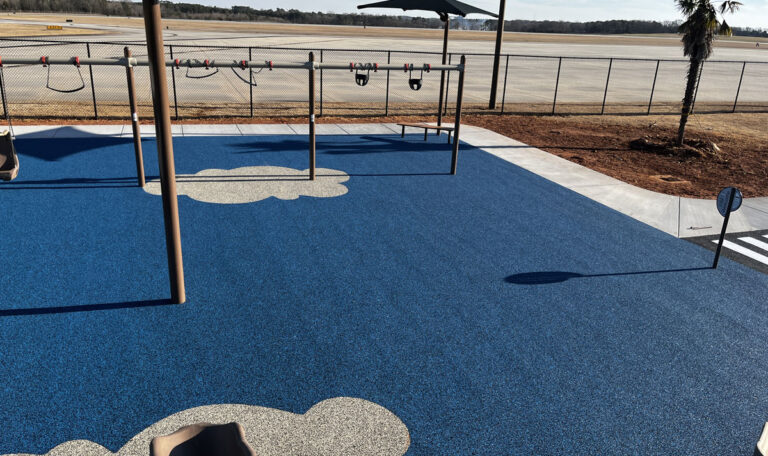The Ultimate Safety and Sustainability Solution for Pool Areas
A rubber pool deck is a durable, slip-resistant surfacing option made from recycled rubber materials that provides superior safety and longevity compared to traditional pool decking materials.
| Key Benefits of Rubber Pool Decks |
|---|
| ✅ Slip-resistant even when wet |
| ✅ Heat-resistant (stays cooler than concrete) |
| ✅ Durable with 12-15 year lifespan |
| ✅ Low maintenance requirements |
| ✅ Made from recycled materials (eco-friendly) |
| ✅ Customizable colors and designs |
| ✅ Shock-absorbing for improved safety |
| ✅ Weather-resistant (won’t crack or warp) |
Are you tired of slippery concrete pool decks that get scorching hot in summer? A rubber pool deck might be exactly what you need. This innovative surfacing solution transforms your pool area into a safer, more comfortable, and environmentally friendly space.
Unlike traditional concrete or pavers, rubber pool decking stays cool underfoot even on the hottest days. Its naturally slip-resistant surface provides crucial safety in wet areas where falls are common. And with a typical lifespan of 12-15 years, it offers excellent durability with minimal maintenance.
What truly sets rubber pool deck surfacing apart is its environmental impact. Instead of ending up in landfills, old tires and rubber materials get a second life as your beautiful pool surround. The flexible nature of rubber also means it won’t crack or warp with temperature changes or ground movement.
I’m Landon Olson from Replay Surfacing, where we’ve transformed countless hazardous waste materials into durable rubber pool deck surfaces that stand the test of time while protecting both people and our planet. Our recycling processes have diverted millions of pounds of scrap tires from landfills into functional, safe pool surroundings that our clients love.
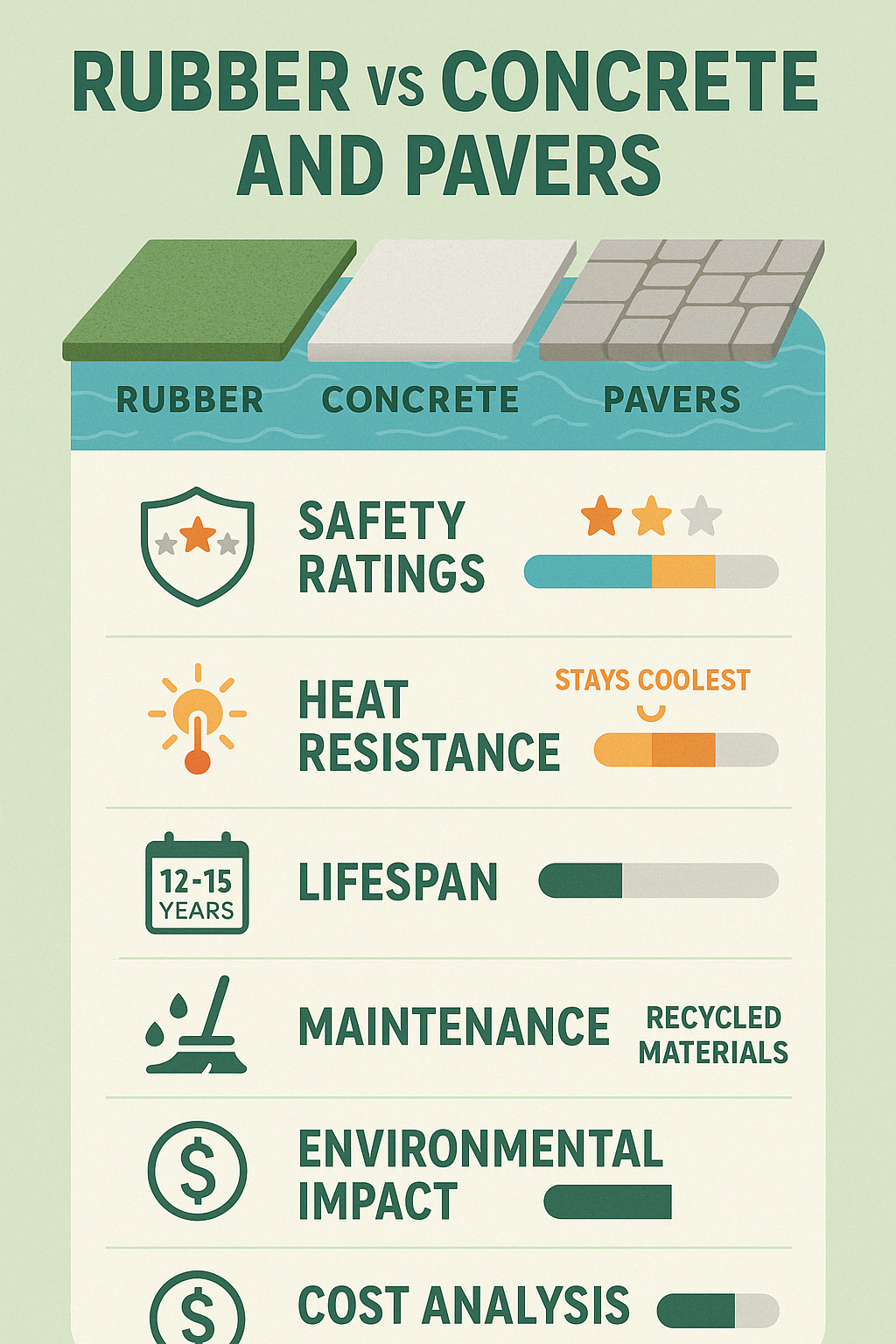
Terms related to rubber pool deck:
What is Rubber Pool Decking?
Ever wondered what makes a rubber pool deck so special? Imagine walking barefoot around your pool on a surface that stays cool, doesn’t get slippery when wet, and actually helps protect our planet. That’s the magic of rubber pool decking!
At its heart, a rubber pool deck is created from recycled rubber—primarily old tires that would otherwise sit in landfills for centuries. Here at Replay Surfacing, we collect these discarded tires and transform them into something beautiful and functional for your home. We carefully process the tires into rubber granules of different sizes, then mix them with special polymer resins to create a surface that’s both flexible and incredibly durable.
The change is quite remarkable. Those old tires that once traveled thousands of miles on highways get a second life as a comfortable, safe surface for your family to enjoy. It’s sustainability in action—turning what would be waste into something wonderful.
What makes rubber pool decking truly stand out is how versatile it is. We can install it over just about any solid surface—old concrete, asphalt, wood, tile, brick, metal, or paving stones. This means you don’t have to tear out your existing pool deck, saving you time, money, and a whole lot of mess. Whether you’re building a new pool or giving your current one a facelift, rubber decking adapts beautifully to your needs.
The installation process is fascinating to watch. Our team hand-trowels the rubber mixture onto your existing surface, creating a seamless finish without joints or gaps. This eliminates those annoying trip hazards found in traditional decking and creates a continuous, beautiful surface that follows whatever shape your pool area might have.
And don’t think you’re limited to basic black! Rubber pool decking comes in a rainbow of colors and can be arranged in countless patterns and designs. Want something that complements your home’s exterior? Looking for a playful pattern that makes your backyard pop? We can make it happen, creating a custom look that’s uniquely yours while still delivering all the practical benefits of this eco-friendly material.
When you choose a rubber pool deck, you’re not just making a smart choice for your family’s safety and comfort—you’re also making a choice that helps our environment by giving new purpose to materials that would otherwise contribute to our growing waste problem. It’s a small step that makes a big difference, one backyard at a time.
Benefits of Rubber Pool Decking
When it comes to creating the perfect pool area, the benefits of choosing a rubber pool deck go far beyond what meets the eye. Homeowners and facility managers alike are finding why this innovative solution is making such a splash in the pool decking world.
Safety Features of Rubber Pool Decks
Let’s face it – wet pool decks and running children aren’t exactly a safe combination. That’s where rubber pool decking truly shines. Unlike slippery concrete or tile, rubber maintains its grip even when soaking wet, dramatically reducing those heart-stopping slip and fall moments that every pool owner dreads.
“The concrete around our community pool was becoming a liability with several slip-and-fall incidents each summer,” shares a property manager from Charlotte, NC. “After installing a rubber pool deck, we haven’t had a single incident in three years. Parents are noticeably more relaxed while their children play.”
What really sets a rubber pool deck apart is its forgiving nature. The slight cushioning effect means that when little ones (or adults!) take a tumble, the impact is significantly reduced. This shock absorption is particularly valuable for family pools, senior communities, and public facilities where safety is paramount. The continuous, toe-friendly surface eliminates the trip hazards of uneven pavers or cracked concrete, creating a safer environment for everyone to enjoy.
Durability and Weather Resistance of Rubber Pool Decks
Mother Nature can be tough on outdoor surfaces, but rubber pool decking stands up to her challenges with remarkable resilience. Unlike concrete that cracks during freeze-thaw cycles, rubber flexes with temperature changes and ground movement, maintaining its integrity season after season.
“Rubberized pool decks are great. They are cooler than concrete,” notes an industry expert. This temperature regulation is a game-changer during hot summer months when traditional surfaces can become uncomfortably hot – even causing burns to bare feet. Your family can comfortably walk from pool to towel without the familiar “hot-foot dance” that comes with concrete decking.
A properly installed rubber pool deck typically lasts 12-15 years with minimal maintenance, standing strong against UV rays, chlorine splash, heavy foot traffic, and whatever else your pool area encounters. Its water-resistant properties prevent the deterioration that plagues many traditional decking materials, saving you from costly repairs and replacements down the road.
Aesthetics and Customization
Gone are the days when practical meant boring. Today’s rubber pool decking offers stunning design flexibility that can transform your pool area into a personalized outdoor oasis. At Replay Surfacing, we love watching our clients’ faces light up when they realize they don’t have to choose between safety and style.
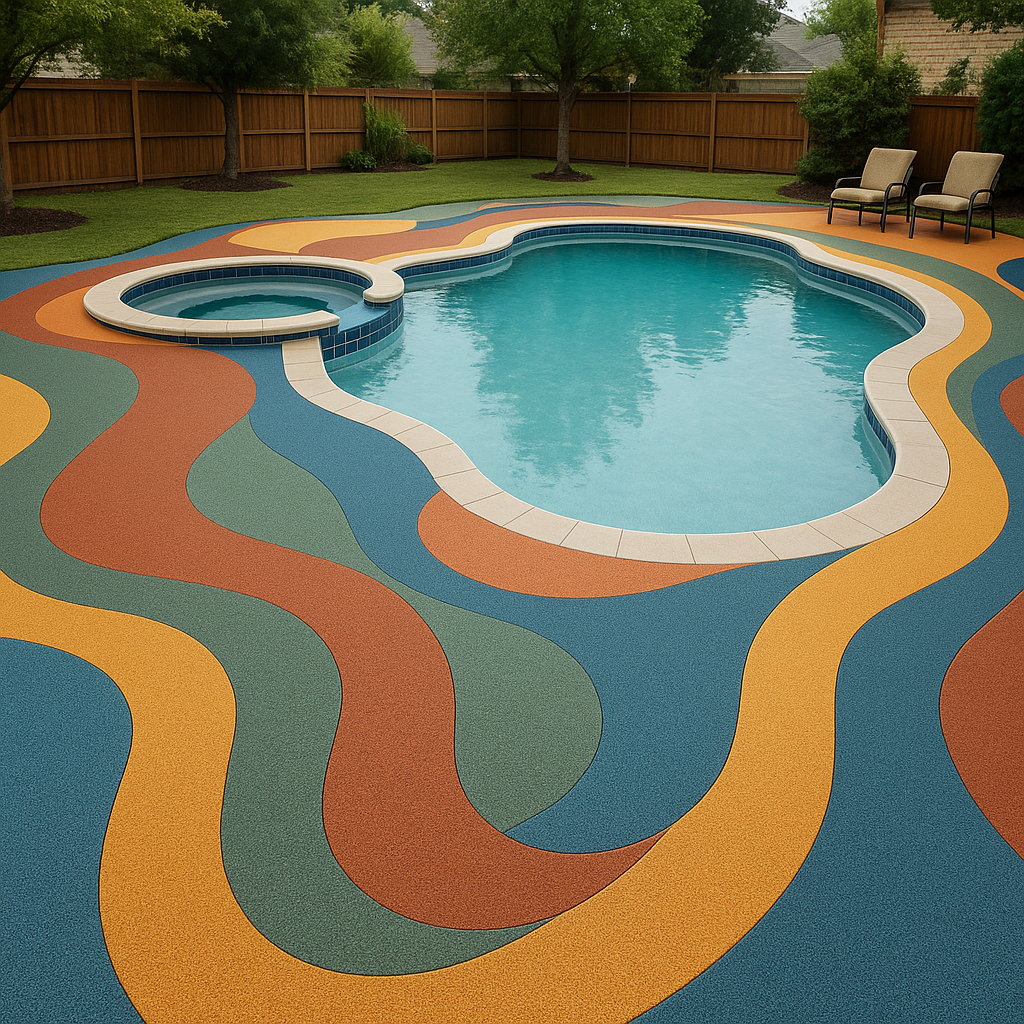
From earthy browns that complement natural landscaping to vibrant blues that echo your pool water, the color options are virtually limitless. The seamless application method allows for creative patterns, borders, and even custom designs that flow beautifully with your outdoor space. Curved pools, unique shapes, integrated steps – a rubber pool deck conforms to whatever vision you have for your backyard retreat.
“We chose a mixture of 40% brown and 60% black rubber which is extremely attractive,” shares George T., a property manager. “It’s so impressive that our office tenants and their clients call the new coating ‘our million dollar sidewalk’. The surface is very durable, makes the building look amazing, is absolutely as anti-slip as anyone could imagine, and is very easy to clean.”
Environmental Sustainability
When you choose a rubber pool deck, you’re not just making a smart choice for your home – you’re making a responsible choice for our planet. At Replay Surfacing, we’re passionate about giving new life to materials that would otherwise contribute to our growing waste problem.
Each rubber pool deck we install helps rescue discarded tires from landfills, where they would otherwise sit for decades leaching chemicals, creating fire hazards, and collecting water that breeds mosquitoes. A typical 500-square-foot pool deck repurposes approximately 75-100 scrap tires – that’s a lot of waste transformed into something beautiful and functional!
The environmental benefits extend beyond waste reduction. Concrete production is one of the largest industrial contributors to carbon emissions worldwide, so choosing rubber helps reduce your carbon footprint. Plus, certain permeable rubber pool deck designs allow rainwater to filter back into the ground, supporting natural water cycles rather than contributing to runoff issues.
For commercial properties seeking LEED certification or homeowners simply wanting to make more eco-conscious choices, a rubber pool deck represents that rare sweet spot where personal benefits and environmental responsibility perfectly align.
For more information about the environmental impact of tire waste and recycling efforts, visit the EPA’s Scrap Tires page to learn how rubber recycling helps reduce environmental hazards.
More info about Rubber Pool Deck Surfacing
Comparing Rubber Pool Decking to Traditional Materials
When you’re weighing your options for pool surroundings, it helps to see how rubber pool decking stacks up against familiar materials like concrete, pavers, and wood. Let’s break down these comparisons in a way that makes your decision easier.
| Feature | Rubber Pool Deck | Concrete | Pavers | Wood Decking |
|---|---|---|---|---|
| Initial Cost | $8-$14 per sq ft | $6-$12 per sq ft | $10-$20 per sq ft | $15-$25 per sq ft |
| Installation Time | 1-3 days | 3-7 days + curing | 2-5 days | 3-7 days |
| Lifespan | 12-15 years | 10-20 years (with repairs) | 10-15 years | 5-10 years |
| Slip Resistance | Excellent, even when wet | Poor when wet | Moderate, varies | Poor when wet, deteriorates |
| Heat Resistance | Stays cool in sun | Gets very hot | Gets hot | Gets hot, splinters |
| Maintenance | Low (occasional cleaning) | Moderate (sealing, crack repair) | High (weed control, settling) | High (staining, sealing, repairs) |
| Repairs | Easy, localized | Difficult, often visible | Moderate, replace individual pavers | Moderate to difficult |
| Comfort Underfoot | Soft, cushioned | Hard, unforgiving | Hard, uneven joints | Moderate, splinter risk |
| Customization | Highly customizable colors/patterns | Limited without added cost | Moderate variety | Limited to wood types/stains |
| Environmental Impact | Positive (uses recycled materials) | Negative (high carbon footprint) | Moderate | Varies (depends on sourcing) |
Cost Considerations
I often hear from homeowners who initially balk at the price of a rubber pool deck. Yes, the upfront investment might be slightly higher than basic concrete, but let’s talk about the complete picture.
Concrete seems cheaper at first glance, but have you factored in the almost inevitable crack repairs you’ll need after a few freeze-thaw cycles? Or the regular sealing to prevent water damage? Many of my clients end up resurfacing their concrete decks after just 7-10 years, and those slip-resistant treatments wear off faster than you’d think.
With a rubber pool deck, what you see is what you get. That initial price includes benefits that would cost extra with other materials. There’s no need for expensive add-ons or treatments. Plus, you won’t be dealing with the headaches pavers bring – like pulling weeds from between stones or releveling settled sections that create trip hazards.
Safety Comparison
When it comes to safety around water, there’s really no comparison. Rubber pool decking maintains its grip even when completely soaked – something I wish I could say about other materials.
Concrete becomes downright treacherous when wet. You can add texture, but then it’s rough on bare feet and still not as safe as rubber. Pavers might look nice initially, but give them a season or two and you’ll find slippery algae growing between them, not to mention the uneven edges as they settle.
And wood decking? I’ve seen too many slip-and-fall accidents to recommend it around pools. It becomes extremely slippery when wet and deteriorates quickly with constant moisture exposure.
The cushioning quality of rubber pool decks is another safety feature that’s easy to overlook until you need it. When little ones (or not-so-little ones) take a tumble, that slight give in the surface can mean the difference between a minor incident and a trip to the emergency room.
Longevity and Weather Performance
Living in Charlotte, we see everything from scorching summers to occasional freezes, and this really tests pool deck materials. Rubber pool decking handles these changes beautifully because it’s naturally flexible.
Concrete, for all its strength, doesn’t like movement. Ground shifts, tree roots, or temperature swings often lead to cracks. I’ve seen brand new concrete pool decks develop hairline fractures within months of installation.
Pavers look great in the showroom, but give them a year in the real world and you’ll likely be adjusting uneven stones that have settled at different rates. Wood warps, splits, and eventually rots with the constant moisture exposure around pools.
Rubber pool decks flex with the ground and adjust to temperature changes without breaking. This adaptability is why they maintain their appearance and function years longer with far less maintenance.
Aesthetic Versatility
Beauty matters when it comes to your outdoor space, and rubber pool decking offers design options that might surprise you. Gone are the days of rubber looking like, well, rubber.
The seamless installation creates a clean, uninterrupted surface around your pool – no joints to break up the visual flow or collect dirt. At Replay Surfacing, we can blend custom colors to complement your home’s exterior or create something truly unique. Some clients even incorporate patterns and designs that would be prohibitively expensive with other materials.
Unlike concrete, which often develops uneven discoloration over time, rubber pool decking maintains its appearance remarkably well year after year. The colors stay true, and the surface doesn’t develop the patchwork look that concrete often does after repairs.
This winning combination of practical benefits and aesthetic options is why more and more homeowners are choosing rubber pool decking when they want both performance and visual appeal from their pool surrounds. It’s not just a practical choice – it’s one that looks good for years to come.
Installation Process of Rubber Pool Decking
The installation of a rubber pool deck is where art meets science – a specialized process that transforms recycled materials into a beautiful, durable surface around your pool. When our team at Replay Surfacing arrives at your home, we bring not just materials but years of expertise that ensures your new deck will stand the test of time.
1. Site Preparation
Every great rubber pool deck begins with thorough preparation. Think of this as laying the foundation for success:
“The most important part of any installation happens before we even open a bag of rubber,” says our lead technician. “A perfectly installed surface on a poorly prepared substrate will fail every time.”
We start by thoroughly cleaning your existing surface, removing any dirt, oils, or debris that might prevent proper adhesion. If your concrete has cracks or damage, we repair these issues first – after all, problems below will eventually show up above. We also carefully assess drainage patterns to ensure water flows away from your home’s foundation and doesn’t pool on your new deck.
The final prep step involves carefully masking and protecting surrounding areas – your garden beds, doors, and any features that won’t be receiving the rubber treatment. This attention to detail is what separates a professional installation from amateur attempts.
2. Material Mixing
Unlike pre-manufactured products that come in rigid formats, your rubber pool deck is custom-mixed right at your home. This on-site approach allows us to tailor the exact color, texture, and performance characteristics to your specific needs.
Our technicians carefully measure recycled rubber granules – diverted from landfills where they would have remained for centuries – and combine them with high-tech polymer resins in precise ratios. If you’ve chosen a custom color blend (perhaps to match your home’s exterior or create a specific aesthetic), we incorporate these colorants during this mixing phase.
The mixing process requires both scientific precision and practical experience. Too much binder creates a surface that’s too hard and loses shock absorption; too little means poor durability. Our experienced teams have perfected this balance through thousands of installations.
3. Application Process
This is where craftsmanship truly shines. The freshly mixed rubber pool deck material is carefully poured onto your prepared surface, and our skilled technicians begin the meticulous hand-troweling process.
“Working with rubber surfacing is similar to frosting a giant cake,” explains one of our veteran installers with a smile. “You need steady hands, an eye for detail, and the ability to maintain consistent pressure and technique across the entire surface.”
The troweling technique creates the perfect texture – slip-resistant enough for safety but smooth enough for comfort. Our technicians pay special attention to edges and transitions, ensuring a seamless appearance where your rubber pool deck meets other surfaces. This hand-crafted approach allows us to work around existing features like pool ladders, drains, or decorative elements with precision that machine application simply cannot match.
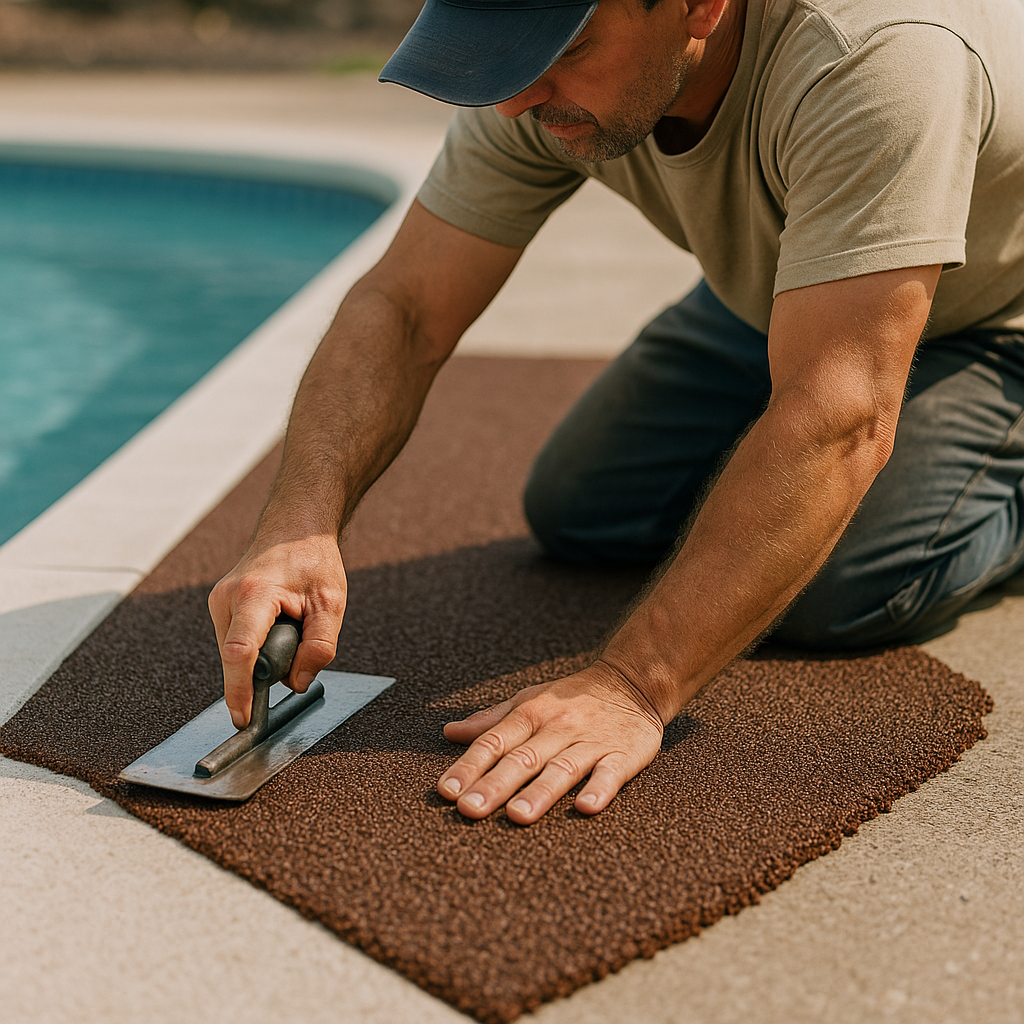
4. Curing and Finishing
After application, your new rubber pool deck needs time to properly cure – though significantly less time than concrete alternatives. The initial setup happens surprisingly quickly, with the surface becoming firm to the touch within hours. Depending on temperature and humidity conditions, light foot traffic is usually possible within 24-48 hours.
Full curing typically takes about 72 hours, during which the polymers complete their chemical bonding process. Before we consider the job complete, our team conducts a thorough final inspection, checking for consistency in texture, color, and thickness across the entire surface.
One of the major advantages of a rubber pool deck installation is the speed – most residential projects can be completed in as little as one day, with the surface ready for full use within 3-7 days. Compare that to concrete, which can require weeks of curing time before sealing and use!
DIY Installation: Is It Feasible?
While you might spot DIY rubber surfacing kits at your local home improvement store, we strongly recommend professional installation for rubber pool decks. Here’s why:
Professional installers bring commercial-grade equipment specifically designed for rubber applications – tools you likely don’t have in your garage. The mixing process requires precise measurements and timing that’s difficult to achieve with household tools. Even more challenging is achieving the consistent thickness and texture that makes rubber pool decks both beautiful and functional.
“I tried installing rubber surfacing myself to save money,” admits Charlotte homeowner Michael R. “After three frustrating days, I had an uneven surface with visible seams. I ended up hiring professionals to remove it and start over – costing nearly twice what professional installation would have originally.”
Beyond the technical challenges, professionals can properly evaluate your existing substrate for issues that might compromise the installation. And perhaps most importantly, professional installation typically includes warranty protection that DIY approaches simply can’t match.
If you’re determined to try a DIY approach, consider starting with a smaller project like a garden pathway before tackling something as significant as a pool deck. But for most homeowners, the investment in professional installation delivers superior results and better long-term value for your rubber pool deck.
Maintenance and Care for Rubber Pool Decks
Let’s face it – nobody wants to spend their weekends maintaining their pool deck when they could be enjoying it instead. One of the biggest advantages of a rubber pool deck is how little maintenance it requires compared to traditional materials. With just a bit of simple care, your rubber surfacing can look great and perform well throughout its entire 12-15 year lifespan.
Regular Cleaning
Keeping your rubber pool deck clean is refreshingly straightforward. For everyday maintenance, a simple hosing down with water takes care of most dirt, dust, and debris. This quick rinse is particularly helpful after storms blow through or during those weeks when pollen seems to coat everything in sight.
When you need a more thorough cleaning, just grab some mild soap and water with a soft-bristle brush or mop. This gentle approach removes most stains and spills without damaging the surface. You’ll want to avoid harsh chemicals or abrasive cleaners that could potentially harm your rubber deck.
“Maintenance is incredibly simple compared to our old concrete deck,” shares a homeowner from Raleigh, NC. “I just hose it down occasionally and sweep off leaves. We haven’t had to do any major maintenance in the four years since installation.”
If your deck needs a deeper clean, an occasional gentle power washing at low pressure can help maintain its appearance. Just be careful not to crank up the pressure too high, as this might damage the rubber. For fallen leaves and debris, a leaf blower works perfectly to prevent staining and keep your deck looking fresh.
Stain Management
While your rubber pool deck naturally resists most stains, quick attention to spills helps maintain its good looks over time. Organic stains from leaves, berries, or food should be cleaned up promptly. For sunscreen and oils that inevitably find their way onto pool decks, a simple solution of mild dish soap and water does the trick.
Since you’re using your deck around a pool, regular rinsing helps prevent chlorine concentration that might affect the coloring over time. What’s remarkable is that most stains that would permanently mark concrete or pavers can be removed from rubber surfacing with standard cleaning methods – making it ideal for high-traffic areas like pool surrounds where spills are inevitable.
Long-Term Maintenance
To get the maximum lifespan from your rubber pool deck, a bit of periodic attention goes a long way. An annual inspection for any signs of granulation, small holes, or wear allows you to catch and address small issues before they become bigger problems.
After several years of use and exposure to the elements, applying a rebinder (essentially a clear topcoat that reinforces the binding agents) can extend the life of your surface. This process is straightforward – thoroughly clean the surface and then apply the rebinder with a standard paint roller.
Unlike concrete, which often requires extensive repairs when damaged, small problem areas in rubber surfacing can be patched relatively easily without leaving visible seams. This targeted repair approach saves both time and money compared to traditional decking materials.
“If you are on top of this crucial maintenance program, your pool deck surface will last a long time and you won’t have to engage in costly repairs,” explains one of our rubber surfacing specialists at Replay Surfacing.
Seasonal Considerations
Your rubber pool deck performs admirably in all seasons, but a few seasonal maintenance tips can help it look its best year-round. In colder climates, use plastic snow shovels rather than metal ones to avoid scratching or damaging the surface. Most de-icing products are safe to use, but it’s always wise to confirm compatibility first.
When spring arrives, a more thorough cleaning helps remove winter’s accumulated grime and prepares the surface for heavy summer use. During fall, removing fallen leaves promptly prevents tannin staining and keeps drainage pathways clear.
One of the hidden benefits of many rubber pool deck installations is their somewhat porous nature, which helps with drainage and prevents standing water. This feature contributes to the deck’s year-round performance and further reduces maintenance headaches compared to traditional materials.
At Replay Surfacing, we’ve seen how our rubber deck installations stand up to years of use with minimal care. Our customers consistently tell us that the low maintenance requirements are one of the features they appreciate most about their investment.
More info about Rubberized Pool Deck Coating
Potential Drawbacks and Common Misconceptions
Let’s be honest – while I absolutely love rubber pool decking (and have installed it for countless happy clients), no surfacing solution is perfect for everyone. Before you make your decision, let’s talk through some considerations that might help you determine if it’s right for your specific situation.
Initial Investment Considerations
I won’t sugarcoat it – the upfront cost of a rubber pool deck typically runs between $8-$14 per square foot, which might cause a bit of sticker shock compared to basic concrete options. However, this is definitely a case where thinking long-term pays off.
A homeowner from Tucson shared with me: “The initial quote for our rubber pool deck was about 20% higher than stamped concrete. But after five years, we’ve spent nothing on maintenance while our neighbors have already resealed their concrete twice and repaired several cracks.”
When you factor in reduced maintenance costs, a longer usable lifespan without major repairs, and built-in safety features that would require expensive add-ons with other materials, the value proposition becomes much clearer. For commercial properties, there’s even potential savings on liability insurance due to the improved safety profile.
Aesthetic Considerations
Modern rubber pool decking has come a long way from the playground-style surfaces of the past. We now offer numerous color and design options that can complement virtually any outdoor space. That said, there are some aesthetic limitations worth noting.
The appearance, while attractive and customizable, does have a distinct look that differs from natural stone or decorative concrete. If you’re dreaming of very intricate patterns or specific architectural styling, we should talk through whether rubber surfacing can achieve your exact vision.
Some color fading may occur over time, particularly with darker colors in areas with intense sun exposure. We typically recommend slightly lighter color blends in sun-drenched regions to minimize this effect. The unique texture of rubber surfacing also has a specific look and feel that, while most people love, may not match every architectural style.
Performance Limitations
Though highly durable (and I’ve seen installations withstand over a decade of heavy use), rubber pool decking isn’t indestructible. Like any material, it has its vulnerabilities:
Extremely sharp objects can potentially puncture or cut the surface, so we recommend being careful with things like lawn furniture with metal feet. Certain harsh chemicals like strong solvents should be kept away from the surface. Direct exposure to fire or extreme heat (like placing a grill directly on the surface) should be avoided. And some oils may cause temporary softening of the surface, though they typically won’t cause permanent damage.
The good news? These limitations are generally easy to manage with basic precautions and don’t significantly impact the material’s excellent performance in normal pool environments.
Common Misconceptions
Over the years, I’ve heard plenty of misconceptions about rubber pool decking that simply aren’t true. Let me clear up the most common ones:
“Rubber surfaces get too hot in the sun.” This might be true of old-school black rubber, but properly formulated rubber pool decking actually stays significantly cooler than concrete or pavers. The composition and typically lighter coloring make a huge difference in temperature – something your bare feet will appreciate on hot summer days!
“Rubber surfaces look like playground material.” Modern rubber pool decking bears little resemblance to playground surfacing. With sophisticated color blends and finishes, our installations complement even the most upscale outdoor designs. Most visitors won’t even realize it’s rubber until you tell them (and they feel how comfortable it is underfoot).
“Rubber surfacing won’t last in harsh weather.” In reality, properly installed rubber pool decks are specifically engineered to withstand extreme weather conditions. From scorching desert heat to freeze-thaw cycles in northern climates, these surfaces remain flexible and resilient where other materials would crack or deteriorate.
“Rubber surfaces harbor bacteria.” Quality rubber pool decking is actually non-porous or semi-porous, making it resistant to bacterial growth compared to materials with joints and crevices where moisture collects. This makes it easier to keep clean and sanitary.
“DIY installation saves significant money.” While DIY might seem tempting, the specialized materials, equipment, and expertise required for quality installation mean professional application almost always provides better value and results. I’ve unfortunately seen many DIY attempts that ended up costing more to fix than a professional installation would have in the first place.
Understanding these potential limitations and misconceptions allows you to make an informed decision about whether a rubber pool deck is right for your property. For most pool owners seeking safety, durability, and low maintenance, the benefits far outweigh these considerations.
Frequently Asked Questions about Rubber Pool Decking
How Much Does Rubber Pool Decking Cost?
When homeowners ask me about the cost of rubber pool decking, I always give them the straight answer: you’re typically looking at $8 to $14 per square foot for professional installation. But as with any home improvement project, several factors influence where your project falls in that range.
The size of your pool deck makes a big difference – larger projects often benefit from better economies of scale, bringing that per-square-foot cost down. The condition of your existing surface matters too; if we’re working with a cracked, uneven concrete pad, there’s more prep work involved than a smooth, stable surface.
“We initially hesitated at the price quote for our rubber pool deck,” a homeowner from Nashville once told me. “But after calculating what we’d spend on concrete sealing, crack repairs, and slip-resistant treatments over time, the rubber option actually worked out to be more economical in the long run.”
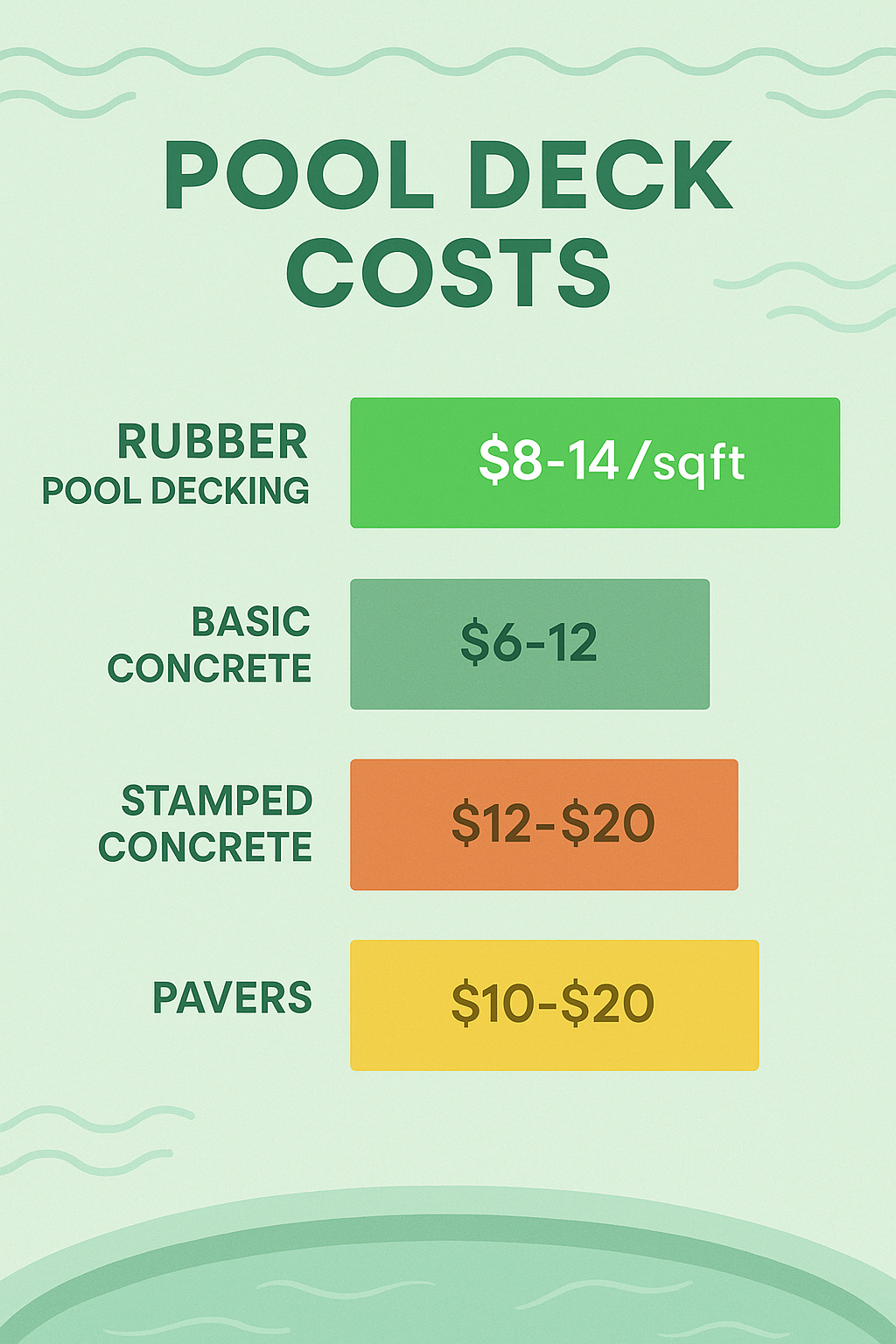
Your design choices also influence the final price. Simple, single-color applications cost less than custom patterns or multiple color blends. And like everything these days, geography plays a role – labor and transportation costs vary depending on where you live.
For comparison shopping, basic concrete typically runs $6-$12 per square foot, while fancy stamped concrete jumps to $12-$20. Pavers generally cost between $10-$20 installed. So while rubber pool decking might seem like a premium option initially, the total ownership cost often tells a different story when you factor in durability, safety features, and minimal maintenance requirements.
At Replay Surfacing, we believe in transparency. That’s why we provide detailed quotes that break down all costs involved, helping you understand exactly what you’re investing in and why.
How Long Does a Rubber Pool Deck Last?
I love when clients ask about longevity because it’s where rubber pool decking really shines. With proper installation and basic maintenance, you can expect your rubber surface to last 12-15 years before needing significant attention. That’s impressive when you compare it to alternatives.
Concrete might technically last 20+ years structurally, but ask any pool owner with a concrete deck over 7-10 years old about the cracks, discoloration, and constant repairs. Pavers look great initially but often need substantial releveling after a decade as the ground beneath shifts. And wood decking? Even with pressure treatment and regular maintenance, you’re looking at replacement after 5-10 years in the harsh pool environment.
A family from Columbia, SC shared this with me: “We installed our rubber pool deck when our daughter was born. She’s now 14, and the surface still looks great with just basic maintenance—it’s essentially lasted her entire childhood.”
Several factors influence just how long your investment will last. Professional installation makes a huge difference – this isn’t a DIY project if you want maximum lifespan. Regular cleaning and occasional rebinding treatments extend surface life considerably. While extreme weather can affect any outdoor surface, rubber pool decks handle climate variations remarkably well.
Here’s a bonus that not everyone realizes: even when your rubber surface eventually reaches the end of its primary lifespan, you often don’t need to tear everything out. In many cases, we can apply a new layer over the existing surface, saving you money and reducing environmental impact during renovation.
Is Rubber Pool Decking Worth It?
This might be the most important question of all. When clients ask if rubber pool decking is “worth it,” I encourage them to look beyond just the price tag to consider the full picture.
The safety benefits alone convince many families. The naturally slip-resistant surface stays grippy even when wet, potentially preventing dangerous falls. When someone does take a tumble, the slight cushioning effect of rubber reduces impact injuries compared to concrete. For households with young children or seniors, this peace of mind is invaluable.
From a financial perspective, while the initial investment is comparable to premium decking options, the maintenance savings add up quickly. No sealing, no crack repairs, no replacement of damaged sections – just occasional cleaning and far less upkeep than traditional materials require.
Wade D., a CPGA Professional who installed our rubber surfacing at a golf club fitting center, told us: “It looks great and the color is perfect!! When we expand the center, we will be sure to call you to add more rubber stone flooring.”
The practical benefits make daily life around your pool more enjoyable too. Rubber pool decking stays remarkably cooler underfoot than concrete or pavers on hot summer days, extending your comfortable swimming season. It stands up beautifully to pool chemicals and salt water without deterioration. And for bare feet, the comfortable surface is neither too hard nor too soft – just right for poolside relaxation.
I’m particularly proud of the environmental benefits we offer at Replay Surfacing. Each rubber pool deck repurposes waste materials that would otherwise end up in landfills. By choosing rubber, you’re reducing the demand for new concrete production (a major carbon emitter) and creating a surface that won’t need replacement nearly as often as alternatives.
For most pool owners I work with, this combination of safety, reduced maintenance, comfort, and environmental responsibility makes rubber pool decking a worthwhile investment – especially when they consider the total cost of ownership over the product’s lifespan rather than just the installation price.
Conclusion
A rubber pool deck isn’t just another option in a sea of surfacing materials—it’s a thoughtful solution that addresses real problems pool owners face every day. After exploring all the benefits throughout this guide, it’s clear why more and more homeowners are making this choice for their outdoor spaces.
Think about what matters most around your pool area. Safety is surely at the top of your list, and rubber pool decking delivers with surfaces that provide reliable traction even when soaking wet. Parents can relax a little more, knowing the forgiving surface will cushion falls if they do happen. That peace of mind alone is worth considering this option.
The practical benefits are just as compelling. While your neighbors are patching cracks in their concrete or replacing warped wooden boards, your rubber pool deck will likely still look great with minimal upkeep. It shrugs off harsh weather, resists damage from pool chemicals, and stays remarkably cooler underfoot during those scorching summer days when concrete would burn bare feet.
What surprises many of our customers is the aesthetic flexibility. Modern rubber pool decking offers beautiful, sophisticated looks that complement any outdoor design. The seamless installation creates clean lines without the interruption of joints where weeds can grow or lips that create tripping hazards. Your outdoor space can reflect your personal style while still being practical.
There’s also something deeply satisfying about making an environmentally responsible choice. At Replay Surfacing, we take tremendous pride in our environmental mission. Every rubber pool deck we install represents hundreds of tires that won’t end up in landfills. Instead, that potential waste becomes a beautiful, functional part of your home that your family will enjoy for years.
From our locations across the country—Charlotte, Columbia, Raleigh, Sanford, Tucson, Connecticut, Indiana, Nashville, Beaverton, and Lake Charles—we’ve helped thousands of homeowners transform their pool areas. Each project represents not just a surface upgrade, but a meaningful improvement in how people enjoy their outdoor spaces.
The question isn’t really whether you can afford a rubber pool deck—it’s whether you can afford not to have one. When you consider the reduced maintenance, improved safety, improved comfort, and environmental benefits, this surfacing option simply makes sense for today’s conscious homeowner.
We invite you to join our community of satisfied customers who have finded the perfect balance of practicality and responsibility. Your pool area deserves a surface that works as hard as you do to create wonderful memories with family and friends.
More info about Rubber Surfacing for Patios, Pools, Decks, Walkways, Driveways
Ready to transform your pool area with a surface that’s safe, durable, and environmentally friendly? Contact Replay Surfacing today for a consultation and find how we can help you create the perfect rubber pool deck for your home or facility.




